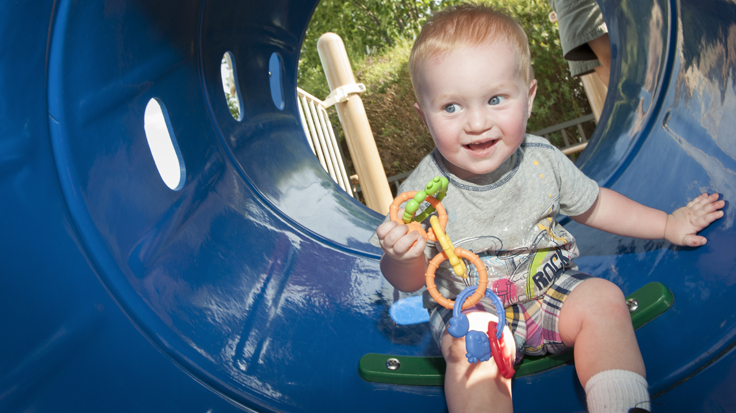
Every expectant parent hopes for a normal pregnancy and delivery, and a perfect, healthy baby. But according to March of Dimes, about 120,000 babies born each year in the U.S. have a birth defect, defined as a health condition present at birth that changes the shape or function of one or more parts of the body.
Alicia and Aaron Burkle of Cleveland Heights, parents to 6-year-old Abigail (Abby), had the same expectation when awaiting the birth of their second child; and throughout what Alicia says was “a totally normal pregnancy and delivery,” they thought that was the case.
But when baby boy Andersen was born on May 1, 2013, at Hillcrest Hospital, doctors and the Burkles noticed a slight crease in his upper lip. There was little concern at that time, but as Andersen grew and went for his 6-month check up, the crease had become more noticeable.
After discussing possible problems that might arise as Andersen continued to grow, Alicia did some research on Cleveland Clinic’s website. She discovered that Brandon Hopkins, MD, a specialist in pediatric otolaryngology (more commonly referred to as ear, nose and throat or ENT) with Cleveland Clinic’s Head & Neck Institute, has a special interest in the surgical correction of cleft and other craniofacial abnormalities.
“We were surprised but relieved to have a diagnosis and plan for treatment presented to us so quickly.”
Within two days of his 6-month check up, Andersen was seen by Dr. Hopkins at the Willoughby Hills Family Health Center. “My plan was to discuss our concerns about how Andersen’s teeth might come in, but as soon as Dr. Hopkins laid eyes on him he said, ‘Oh, he has a cleft lip,’ ” says Alicia. “We were surprised but relieved to have a diagnosis and plan for treatment presented to us so quickly.”
According to Dr. Hopkins, about one in every 500 to 600 children is born with a cleft lip. In most cases, it is an isolated finding that can’t be linked to a specific genetic or environmental cause, but once Andersen was diagnosed, the Burkles learned there was a history of cleft lip on both sides of their family (an aunt and a grandmother).
“There can be a long laundry list of other problems in children born with cleft lips or palates — things that can affect their hearing, speech and even sleep,” says Dr. Hopkins.
“In Andersen’s case, the defect was relatively mild. A muscle did not fully develop, resulting in a gap in his upper lip. Surgery would allow us to connect that gap and make a minor correction to one of his nostrils that was flattened a bit as a result of the cleft.”
Andersen was scheduled for surgery two days after Christmas, but developed a respiratory infection so surgery had to be postponed. “Dr. Hopkins was so kind — he called us the morning the surgery was supposed to have taken place to ask how Andersen was feeling,” says Alicia.
On Valentine’s Day 2014, Dr. Hopkins performed surgery on 9-month-old Andersen at Cleveland Clinic’s main campus. Following a one-and-a-half-hour surgical procedure in which three layers — mucosa, muscle and skin — were reconstructed, the Burkles were taken to see Andersen in recovery, where he was being held in the arms of a nurse, contentedly drinking a bottle of apple juice.
Like most young surgery patients, Andersen stayed one night in the hospital. He went home the next day with sutures under his skin that would dissolve over time, and surgical glue covering the wound on the exterior to allow him to eat, drink and be bathed without risk of infection.
After a few challenges the first week home when Andersen was restricted from crawling (due to arm restraints that helped prevent him from touching his face), life quickly returned to normal for the Burkle family. On May 1, 2014, the Burkles sent a note to Dr. Hopkins stating: “I thought I would share a picture from today, his 1st birthday!! His lip looks amazing and continues to look better every day!! Thank you so much for everything you did.”
Andersen will have a final follow-up visit one year from the date of surgery with Dr. Hopkins, but according to Alicia, “If you didn’t know Andersen had surgery and a scar, you’d never notice it!”
Related Institutes: Head & Neck Institute, Cleveland Clinic Children's

